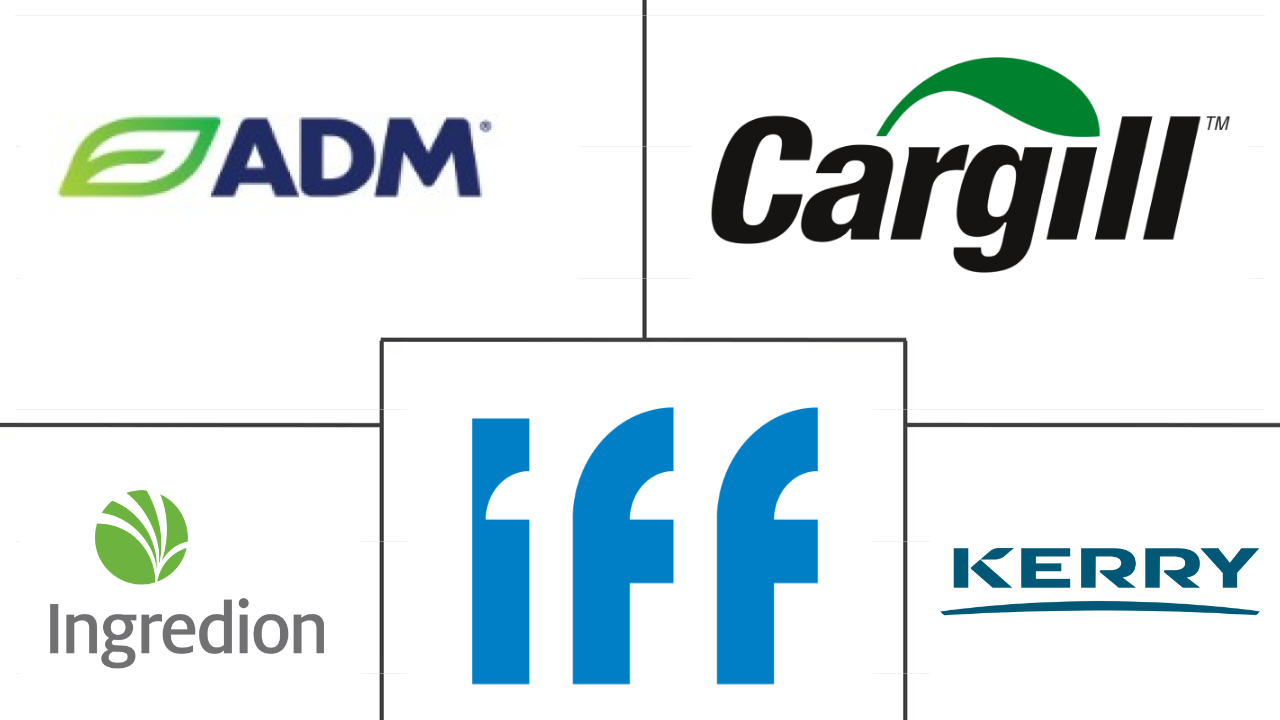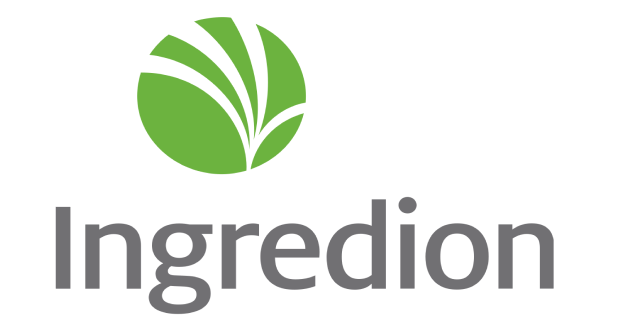Market Size of pea protein ingredients Industry
|
|
Study Period | 2017 - 2029 |
|
|
Market Size (2024) | USD 1.21 Billion |
|
|
Market Size (2029) | USD 1.75 Billion |
|
|
Largest Share by End User | Food and Beverages |
|
|
CAGR (2024 - 2029) | 7.61 % |
|
|
Largest Share by Region | Asia-Pacific |
|
|
Market Concentration | Medium |
Major Players |
||

|
||
|
*Disclaimer: Major Players sorted in no particular order |
Pea Protein Ingredients Market Analysis
The Pea Protein Ingredients Market size is estimated at 1.21 billion USD in 2024, and is expected to reach 1.75 billion USD by 2029, growing at a CAGR of 7.61% during the forecast period (2024-2029).
1.21 Billion
Market Size in 2024 (USD)
1.75 Billion
Market Size in 2029 (USD)
8.84 %
CAGR (2017-2023)
7.61 %
CAGR (2024-2029)
Largest Market by Form
57.56 %
value share, Isolates, 2023
Pea protein isolate's exceptional functionality and label-friendly claims projected drive the segment during the forecast period.
Largest Market by End User
88.02 %
value share, Food and Beverages, 2023
The F&B segment dominates the market due to the high demand for pea protein as a meat alternative, as it provides quick rehydration, neutral taste, and texturizing properties.
Fastest Growing Market by Form
8.08 %
Projected CAGR, Concentrates, 2024-2029
Its gaining popularity over others due to the higher and broader range of protein content along with lower carbohydrate content of pea concentrate compared to pea protein isolates.
Fastest Growing Market by End User
8.06 %
Projected CAGR, Food and Beverages, 2024-2029
The projected growth of the F&B sector is attributed to the constant product launches, driving the demand for pea protein in the meat alternative and snacks industries.
Leading Market Player
20.86 %
market share, Ingredion Incorporated, 2021

To enhance its offering and target broader application sectors, the company is extending its production facility or merging with local firms like Verdient Foods Inc.
With an growing vegan culture demand for pea protein ingredients has been increased across the region
- Pea protein infused products are largely demanded in the global market, owing to its increased functionalities and applications. In 2022, the food and beverage segment accounted for the highest consumption of 88.48% by volume among all application segments. Pea protein is considered a hypoallergenic ingredient that can be used with a combination of ingredients to provide flavor, texture, and balanced nutrition.
- The supplements segment is driven primarily by the sports/performance nutrition sub-segment, which is expected to record a CAGR of 6.85% during the forecast period. While dairy and soy dominate the protein beverage market, 30% of protein beverage consumers in the United States support using plant proteins in protein drinks and 10% of UK consumers avoid soy because they or a household member has a food allergy or intolerance. The remaining 10% avoid soy as part of a healthy lifestyle in general. Pea protein will also benefit from the increased use of popular claims like gluten-free and GMO-free. The sports nutrition sub-segment is expected to account for one of the significant applications for pea protein due to its amino acid composition.
- The animal feed segment accounts for the second-highest application share of pea protein ingredients globally after the food and beverage segment. Pea protein isolates comprised the highest application share in the animal feed segment, with 41.97% by volume in 2022. Its excellent digestibility along with its naturally low antitrypsin activity makes pea protein a protein of choice in the nutrition of young animals particularly piglets. A large number of studies have demonstrated the good palatability and excellent growth performance of a pea protein based diet.
Pea protein is gaining popularity as a substitute for egg protein supported with widespread of veganism across the region
- Asia-Pacific dominates the global pea protein market, driven by the F&B segment, which accounted for 95% of the market share by volume in 2022. In addition, pea protein provides enough viscosity and creaminess, so local manufacturers use pea protein as a substitute for eggs in products like mayonnaise. Pea protein has been touted as a label-friendly, gluten-free, and soy-free alternative. Along with holding the largest share, the Asia-Pacific regional segment is growing significantly and is expected to record a CAGR of 6.53% during the forecast period.
- Asia-Pacific is followed by Europe, primarily led by the F&B segment, which accounted for about 93% of pea proteins used in the region in 2022. The demand for pea protein as an alternative source of protein has been growing as vegan diets are becoming more popular in the region's developed countries. Germany remained the largest consumer of pea protein in the study period due to rising veganism and consumers' growing reliance on meat alternative products.
- The Middle East is projected to be the fastest-growing regional segment, as the demand for natural and sustainable ingredients is rapidly growing due to the rise in health consciousness among consumers. Over the forecast period, the region is set to record a CAGR of 12.21% by volume. Saudi Arabia primarily drives the Middle Eastern pea protein market due to increasing awareness of pea protein use, causing the country's population to adopt it in their diets. However, these proteins have applications in the F&B segment, which was majorly driven by the meat and meat alternative products sub-segment, with a 37% share by volume in 2022.
Pea Protein Ingredients Industry Segmentation
Concentrates, Isolates, Textured/Hydrolyzed are covered as segments by Form. Animal Feed, Food and Beverages, Personal Care and Cosmetics, Supplements are covered as segments by End User. Africa, Asia-Pacific, Europe, Middle East, North America, South America are covered as segments by Region.
- Pea protein infused products are largely demanded in the global market, owing to its increased functionalities and applications. In 2022, the food and beverage segment accounted for the highest consumption of 88.48% by volume among all application segments. Pea protein is considered a hypoallergenic ingredient that can be used with a combination of ingredients to provide flavor, texture, and balanced nutrition.
- The supplements segment is driven primarily by the sports/performance nutrition sub-segment, which is expected to record a CAGR of 6.85% during the forecast period. While dairy and soy dominate the protein beverage market, 30% of protein beverage consumers in the United States support using plant proteins in protein drinks and 10% of UK consumers avoid soy because they or a household member has a food allergy or intolerance. The remaining 10% avoid soy as part of a healthy lifestyle in general. Pea protein will also benefit from the increased use of popular claims like gluten-free and GMO-free. The sports nutrition sub-segment is expected to account for one of the significant applications for pea protein due to its amino acid composition.
- The animal feed segment accounts for the second-highest application share of pea protein ingredients globally after the food and beverage segment. Pea protein isolates comprised the highest application share in the animal feed segment, with 41.97% by volume in 2022. Its excellent digestibility along with its naturally low antitrypsin activity makes pea protein a protein of choice in the nutrition of young animals particularly piglets. A large number of studies have demonstrated the good palatability and excellent growth performance of a pea protein based diet.
| Form | |
| Concentrates | |
| Isolates | |
| Textured/Hydrolyzed |
| End User | |||||||||||||
| Animal Feed | |||||||||||||
| |||||||||||||
| Personal Care and Cosmetics | |||||||||||||
|
| Region | |||||||||||||||||
| |||||||||||||||||
| |||||||||||||||||
| |||||||||||||||||
| |||||||||||||||||
| |||||||||||||||||
|
Pea Protein Ingredients Market Size Summary
The pea protein ingredients market is experiencing significant growth, driven by increasing demand for plant-based protein alternatives across various sectors. The food and beverage industry leads in consumption, with pea protein being favored for its hypoallergenic properties and nutritional benefits. This ingredient is particularly popular in the sports nutrition segment due to its amino acid profile, which supports muscle recovery and performance. The market is also seeing a rise in the use of pea protein in animal feed, where its digestibility and low antitrypsin activity make it an ideal choice for young animals. The Asia-Pacific region dominates the global market, with Europe following closely, as both regions see a growing trend towards vegan and plant-based diets. The Middle East is emerging as a fast-growing market, driven by increasing health consciousness and demand for natural ingredients.
The production of dry peas, the primary raw material for pea protein extraction, is concentrated in regions like North America, China, and India, with Canada being a leading producer. The market is moderately consolidated, with major players like Archer Daniels Midland Company, Cargill Incorporated, and Ingredion Incorporated holding significant shares. Recent developments include the launch of new product lines and investments to enhance production capabilities, which are expected to further strengthen the market position of key players. The rising awareness of the health benefits of plant-based proteins, coupled with changing dietary preferences towards flexitarian and vegan diets, is creating opportunities for innovation and expansion in the pea protein segment globally.
Pea Protein Ingredients Market Size - Table of Contents
-
1. MARKET SEGMENTATION (includes market size in Value in USD and Volume, Forecasts up to 2029 and analysis of growth prospects)
-
1.1 Form
-
1.1.1 Concentrates
-
1.1.2 Isolates
-
1.1.3 Textured/Hydrolyzed
-
-
1.2 End User
-
1.2.1 Animal Feed
-
1.2.2 Food and Beverages
-
1.2.2.1 By Sub End User
-
1.2.2.1.1 Bakery
-
1.2.2.1.2 Beverages
-
1.2.2.1.3 Breakfast Cereals
-
1.2.2.1.4 Condiments/Sauces
-
1.2.2.1.5 Confectionery
-
1.2.2.1.6 Dairy and Dairy Alternative Products
-
1.2.2.1.7 Meat/Poultry/Seafood and Meat Alternative Products
-
1.2.2.1.8 RTE/RTC Food Products
-
1.2.2.1.9 Snacks
-
-
-
1.2.3 Personal Care and Cosmetics
-
1.2.4 Supplements
-
1.2.4.1 By Sub End User
-
1.2.4.1.1 Baby Food and Infant Formula
-
1.2.4.1.2 Elderly Nutrition and Medical Nutrition
-
1.2.4.1.3 Sport/Performance Nutrition
-
-
-
-
1.3 Region
-
1.3.1 Africa
-
1.3.1.1 By Form
-
1.3.1.2 By End User
-
1.3.1.3 By Country
-
1.3.1.3.1 Nigeria
-
1.3.1.3.2 South Africa
-
1.3.1.3.3 Rest of Africa
-
-
-
1.3.2 Asia-Pacific
-
1.3.2.1 By Form
-
1.3.2.2 By End User
-
1.3.2.3 By Country
-
1.3.2.3.1 Australia
-
1.3.2.3.2 China
-
1.3.2.3.3 India
-
1.3.2.3.4 Indonesia
-
1.3.2.3.5 Japan
-
1.3.2.3.6 Malaysia
-
1.3.2.3.7 New Zealand
-
1.3.2.3.8 South Korea
-
1.3.2.3.9 Thailand
-
1.3.2.3.10 Vietnam
-
1.3.2.3.11 Rest of Asia-Pacific
-
-
-
1.3.3 Europe
-
1.3.3.1 By Form
-
1.3.3.2 By End User
-
1.3.3.3 By Country
-
1.3.3.3.1 Belgium
-
1.3.3.3.2 France
-
1.3.3.3.3 Germany
-
1.3.3.3.4 Italy
-
1.3.3.3.5 Netherlands
-
1.3.3.3.6 Russia
-
1.3.3.3.7 Spain
-
1.3.3.3.8 Turkey
-
1.3.3.3.9 United Kingdom
-
1.3.3.3.10 Rest of Europe
-
-
-
1.3.4 Middle East
-
1.3.4.1 By Form
-
1.3.4.2 By End User
-
1.3.4.3 By Country
-
1.3.4.3.1 Iran
-
1.3.4.3.2 Saudi Arabia
-
1.3.4.3.3 United Arab Emirates
-
1.3.4.3.4 Rest of Middle East
-
-
-
1.3.5 North America
-
1.3.5.1 By Form
-
1.3.5.2 By End User
-
1.3.5.3 By Country
-
1.3.5.3.1 Canada
-
1.3.5.3.2 Mexico
-
1.3.5.3.3 United States
-
1.3.5.3.4 Rest of North America
-
-
-
1.3.6 South America
-
1.3.6.1 By Form
-
1.3.6.2 By End User
-
1.3.6.3 By Country
-
1.3.6.3.1 Argentina
-
1.3.6.3.2 Brazil
-
1.3.6.3.3 Rest of South America
-
-
-
-
Pea Protein Ingredients Market Size FAQs
How big is the Global Pea Protein Ingredients Market?
The Global Pea Protein Ingredients Market size is expected to reach USD 1.21 billion in 2024 and grow at a CAGR of 7.61% to reach USD 1.75 billion by 2029.
What is the current Global Pea Protein Ingredients Market size?
In 2024, the Global Pea Protein Ingredients Market size is expected to reach USD 1.21 billion.

